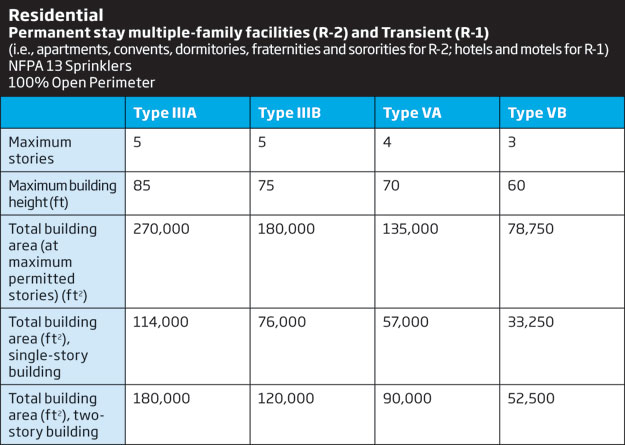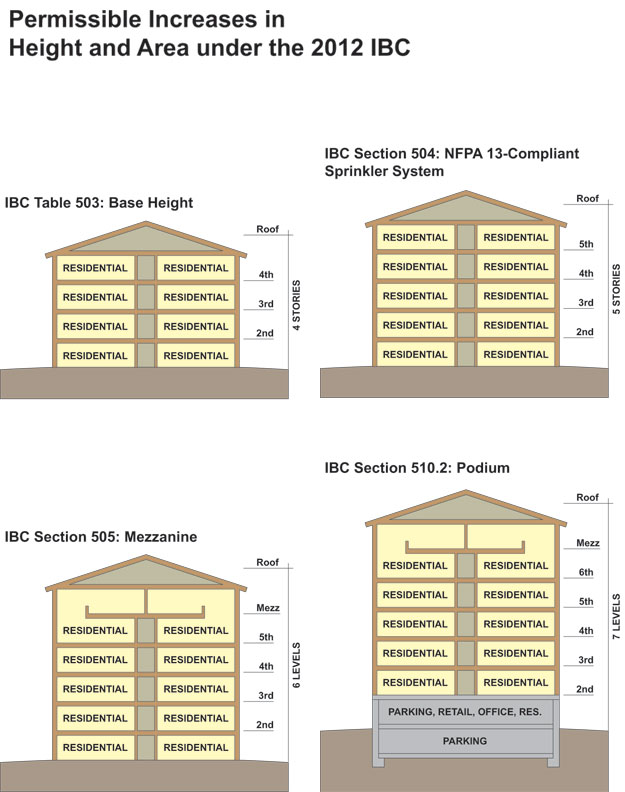Mid-Rise Wood Construction
The following pages will provide an overview of technical considerations related to the design, safety and structural performance of mid-rise wood buildings, as well as two trends that are expanding the opportunities for wood use in multi-story design.
Free project support related to the code-compliant design, construction and engineering of non-residential and multi-family wood buildings is also available through the Wood Products Council's WoodWorks program (woodworks.org; help@woodworks.org).
Building Code Requirements
The IBC is the predominant U.S. model building code, having been adopted by most states with or without amendments. Chapters 16, 17 and 23 cover structural wood design and construction. (Non-structural provisions such as heights and areas are covered elsewhere.) IBC Chapter 6 classifies buildings into five types of construction. Construction Types I and II are generally limited to non-combustible materials such as concrete and steel, although wood can be used in all types of construction to varying degrees. Type III allows a mix of non-combustible and combustible materials, while construction Types IV and V can have combustible building materials.

Source: American Wood Council
Multi-story wood construction generally falls under Types III and V. (However, Type IV multi-story construction, also known as Heavy Timber, is growing in interest.) Each building type is further subdivided into A and B, which have different fire-resistance rating requirements, with A being the more rigorous. (See section: Fire Protection Requirements.) “From a cost perspective it makes no sense to use Type I for five stories,” says Tim Smith, AIA, founding principal of Togawa Smith Martin, Inc., Los Angeles, and a pioneer of five-story wood framing in California. “Type I is more realistic for taller buildings. Type III for wood construction helps fill the gap between low-rise and taller buildings.”

Image: Togawa Smith Martin
Permissible Increases in Area and Height
Table 503 of the IBC lists allowable building heights and floor areas for different construction types; however, there are provisions for increases. For Type IIIA, for instance, an allowable floor area of 24,000 square feet as stipulated in Table 503 for Group R-2 occupancies could be increased to 90,000 square feet per story. Such provisions include:
Open front areas. IBC Section 506.2 permits area increases up to 75 percent for buildings with open spaces around their perimeters such as yards, courts, parking areas and streets, which provide fire-fighting access.
Sprinkler systems. For most occupancy groups, increases to the allowable height (and number of stories) and floor area are permitted according to IBC Section 504.2 with the use of an approved automatic sprinkler system in accordance with the National Fire Protection Association (NFPA) 13 standard.
“Type IIIA construction for Residential Group R is allowed to be four stories and 65 feet high while a Type VA building is permitted to be three stories and 50 feet,” explains Kevin Cheung, Ph.D., P.E., chief engineer for the Western Wood Products Association. “However, when protected by automatic sprinklers, Type IIIA and Type VA buildings are allowed to be five and four stories, respectively. Type IIIA is permitted an increase in height to 85 feet and Type VA an increase to 70 feet.” (See Table of IBC Allowable Heights and Areas for Residential Construction.)
In the Pacific Northwest (Washington, Oregon and Idaho), the model code has been amended to allow Type V residential buildings to have up to five stories of wood-frame construction with additional limitations. In Canada, the British Columbia building code was revised in 2009 to permit residential wood construction up to six stories.

Source: Togawa Smith Martin









